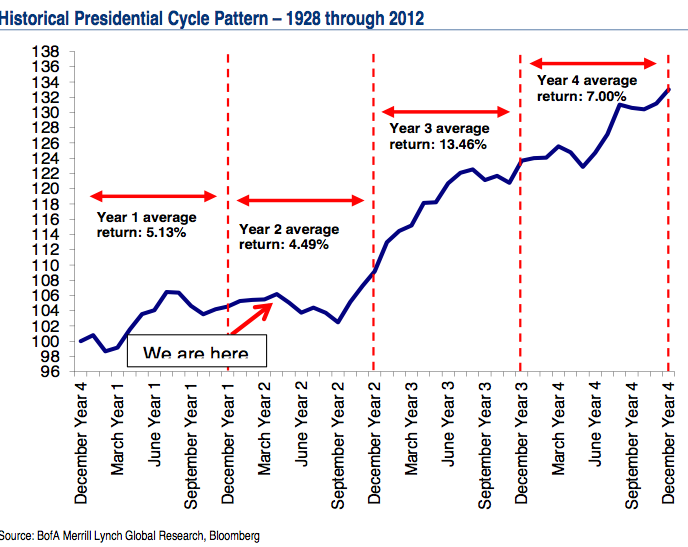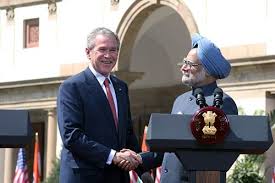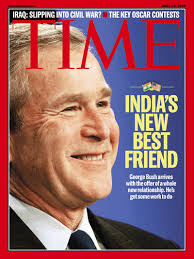The concept of a Presidential Cycle has been an important part of investing lore. Simply put, the first two years of each Presidential term are basically flattish while the third year is always a decidedly up year. Different Presidents, different political parties, different political ideologies, different global conditions but somehow all this diversity coalesces into the same statistical outcome – a strong up year in the stock market in the third year of the Presidential Cycle.

We wrote about a similar pattern in the US-India relationship in our August 2, 2014 article. Unlike the BofA Merrill Lynch study, our sample size is much smaller – Presidents Clinton, Bush & now Obama. These are very different men and their presidencies have been very different in orientation, objectives & successes. They came to power with very different perspectives about India. But the sixth year of their presidencies has turned out to be remarkably similar – a pivotal upturn in the US-India relationship.
India was quite irrelevant to President Clinton when he took office in 1992. In fact, he considered Indian democracy to be a pain and preferred the ease & certainty of Non-Pakistan. He chose Robin Raphel as the nation’s first Assistant Secretary of State for South and Central Asian Affairs, the same Ms. Raphel who is now reportedly under federal investigation as part of a counterintelligence probe and whose State Department office was reportedly examined and sealed.
Then came India’s nuclear test in 1998. This enraged President Clinton and he slapped sanctions on India that continue to negatively impact US-India defense ties to this day. But as Rudra Chaudhuri reported in his book “Forged In Crisis”,
- “Talbott likewise concluded that one of the expected consequences of the tests was that the US would “pay them [India] serious, sustained, and respectful attention of a kind the Indians felt they had never received before“”.
The year 1998, the sixth year of the Clinton presidency, marked a decisive up turn in the US-India relationship. One year later, Clinton “unequivocally took India’s side” in the 1999 Kargil conflict. Another year later, he visited India in a literally euphoric visit.
President George W. Bush truly transformed America’s relationship with India. His view was profoundly simple. China & India were destined to be nations of great importance in the 21st century. Which of these two nations would be a better partner for America? India without question was his answer. His administration, led by Dr. Condoleeza Rice, worked tirelessly to change America’s previous policy of hyphenating “India-NonPakistan”.
The result was the United States and India;Strategic Partnership unveiled during President Bush’s trip to India in 2006, the sixth year of his presidency. Two years later, the U.S. – India Civil Nuclear Agreement was ratified. This end to India’s nuclear isolation was hailed by the Times of India as “Max Americana“.


President Obama came to power in 2008 with a desire to re-restore the old “balance” between India & Non-Pakistan. His visit to India in 2009 was a media success but not much more. Very simply, Obama’s core goals were in direct conflict with India’s core strategic interests. We discussed this reality in our April 2010 article Obama’s India Problem or India’s Obama Problem. Naturally, US-India relations lost steam and got sidelined. Until this year, the sixth year of the Obama Presidency.
The stunning election victory of Prime Minister Modi and his immediate enthusiastic embrace by President Obama marks a major upturn US-India relationship. How major? President Obama will be the first U.S. President to be honored as the Chief Guest for India’s Republic Day. How major again? President Obama is rescheduling the annual State of the Union address to the nation & the Congress to make time for the India visit.
So once again & for the third consecutive presidency, the sixth Presidential year marks a decisive & pivotal up turn in US-India relations. What accounts for this – numerology or some astrological pattern of planetary events? But then what accounts for the clear evidence of the importance for the stock market of the third year of presidencies?
Like the Presidential cycle in the stock market, one can draw on some real world arguments. The mid term elections in the sixth year of a presidency usually result in losses for the President’s party. President Obama suffered a major defeat in this month’s elections and lost the U.S. Senate to the Republicans. President Bush suffered a similar defeat in 2006 and lost the House of Representatives to the Democrats. The sixth year is also notorious for embroiling presidents in crisis, usually of their own making. The Monica Lewinsky scandal broke hard in 1998 and President Clinton’s popularity nosedived. The Iran Contra affair broke in November 1986, the sixth year of the Reagan presidency and Reagan’s popularity fell sharply.
Faced with rancorous criticism at home, Presidents tend to look to foreign policy to uplift their image and to establish a legacy of achievement. The US-India Strategic Partnership of President Bush was hailed as comparable to President Nixon’s opening to China in 1972. Interestingly, the up coming visit of President Obama as India’s Chief Guest is also being compared to President Nixon’s visit to China in 1972. The Republic Day parade in Delhi provides fantastic photo-ops and images of President Obama being welcomed & felicitated in India will be flashed all over American Television in January 2015.
This focus on India in the crucial sixth year of Presidential Cycle marks a critical coming of age in US-India relations. It demonstrates that good relations with India has now become a critical non-controversial and bi-partisan goal for the entire American establishment. And a visit to India is now regarded as a genuinely positive media opportunity for an American President to demonstrate his international standing. That is today’s enormously satisfying reality for this Indian-American and for all people of Indian origin in the world.
So call it numerology, astrology or sheer coincidence. The sixth year of the Presidential Cycle is now to be celebrated by Indian-Americans just as stock market investors celebrate the third year of the Presidential term. .
Recall what we wrote on August 2, 2014:
- “In a sense, the US-India relationship has nowhere to go but up from its current level. We trust the Obama-Modi meeting does indeed take it to the next level. And if it does, then perhaps we can see a triumphant visit of President Obama to India, a visit that exceeds the “Clinton mania” that engulfed India in 2000.”
Who knew the triumphant visit would come so soon? We can’t wait for January 26, 2015.
Send your feedback to editor@macroviewpoints.com Or @MacroViewpoints on Twitter



Nice write up, with even nicer mascots ! (I’m of course referring to the babes with the pics on their skins 🙂 … Now your blogs will get even more folowers, since a pic = wordsX1000 !